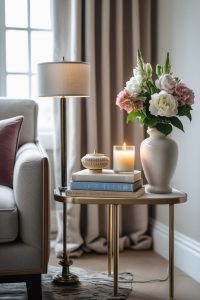
Side Table Decor Secrets Interior Designers Swear By
Why Side Tables Deserve More Attention
Side tables often play a supporting role in a room but done right, they can completely change the feel of a space. Interior designers know this, and they treat side tables not just as functional furniture, but as key styling opportunities.
Whether it’s next to a bed, sofa, or reading chair, the right side table decor can tie your design scheme together, add personality, and bring balance. The trick is in how you layer objects, use scale, and maintain both style and function.
In this post, we’ll walk through the simple styling principles designers swear by, so you can recreate the look in your own home without guesswork.
1. Work with a Base Layer
Every well-styled table starts with a base element. This could be a stack of books, a tray, or a placemat that anchors the items above it. Designers use this trick to keep things grounded and avoid that “floating clutter” look.
Stacks of coffee table books are a classic choice. Choose titles that reflect your interests or match your room’s colour palette. Trays are another go-to, they organise smaller items and keep the arrangement contained.
Tip: Use hardback books with visually appealing covers and vary the stack height depending on your table size.
2. Add a Source of Light
Lighting adds both style and function. A small table lamp with an interesting base can become the hero piece of your table. Designers often choose lamps that contrast with the table’s texture think brass on wood, or ceramic on glass.
In bedrooms, opt for soft, warm lighting. In living spaces, dimmable or layered lighting creates ambience. If a lamp won’t fit, a small lantern or decorative candle works as well.
Tip: Lamps with sculptural bases double as decor even when switched off.
3. Bring in Something Living
Adding a natural or organic element makes the table feel alive. A small vase of fresh flowers, a low-maintenance houseplant, or even a bowl of seasonal fruit can soften the setting and add freshness.
Designers often use florals or greenery as the finishing touch that ties the whole arrangement together. Just keep the size in check nothing too large or it will overpower the surface.
Tip: Dried florals or faux greenery are great alternatives if you’re not into plant maintenance.

4. Mind the Scale and Balance
A common mistake is cramming too much on the table or using items that are all the same size. Professional designers think in layers and height variation. Pair something tall (a lamp), medium (a vase or jar), and small (a trinket dish or candle).
This helps the eye move around the space and creates a balanced, intentional feel. Use the “triangle rule” to form a loose visual triangle with your objects this layout feels naturally pleasing.
Tip: Don’t forget negative space. Leave some room so the surface doesn’t feel overcrowded.
5. Use Scent to Add Another Layer
Scent is a subtle but powerful way to elevate your space. Designers often include a scented candle, reed diffuser, or incense to create a multi-sensory experience. It’s the detail that guests notice even if they can’t quite put their finger on why the room feels so inviting.
Choose scents that reflect the season or the mood you want to evoke, think citrus and florals in spring, warm woods in winter.
Tip: Stick to one fragrance per area to avoid clashing smells.
6. Rotate Items Seasonally
Designers rarely leave their side tables looking the same all year round. Rotating decor with the seasons keeps things feeling fresh and gives you a chance to play with different textures, colours, and themes.
In spring, you might add a vase of tulips. In winter, a small pine arrangement or festive ornament. Just a few thoughtful swaps can make the whole space feel updated without a complete overhaul.
Tip: Keep a small box of decor items to rotate through the year, it makes styling quicker and more intentional.
7. Make It Personal
Designers always incorporate something personal into side table styling. A framed photo, a favourite book, a small travel souvenir, it tells your story and prevents the space from feeling like a showroom.
The key is editing. Choose one or two items that are meaningful but still complement the overall aesthetic. Sentimental doesn’t have to mean messy.
Tip: If something feels out of place visually, group it with similar colours or textures to make it feel cohesive.
Style with Purpose
Styling a side table doesn’t require an interior designer, it just requires intention. By following these tried-and-tested principles, you can turn a simple surface into a curated display that adds depth and beauty to any room.
Keep things functional, add your personality, and don’t be afraid to experiment. Sometimes the smallest spaces make the biggest impact.
Post a Comment
You must be logged in to post a comment.



